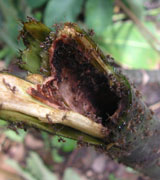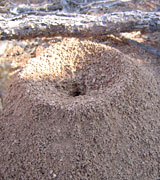What Ants to Look For
Many people think there are only two kinds of ants, red ants and black ants. But boy are they wrong! Ants are a great example of diversity: all of the different species come in all kinds of shapes and sizes, they all behave differently, and they eat different things and live in different places. To help you learn about the different shapes and sizes of ants, we have a cool article on ant heads. On top of that, scientists know of at least 9000 different kinds of ants that are found all over the world, and we think there could be another 9000 kinds of ants that we don’t know anything about yet!
When you decide to look for ants, you will have to pay attention to just two important things: whether or not the ants sting, and the places where ants like to make nests.
Some kinds of ants, but not all of them, have stingers, just like wasps and bees. A lot of people think that ant bites are a big problem, but it’s actually stinging that, well, stings. Ants only sting to defend their colonies from you, so it’s probably best to just leave stinging ants alone. Fortunately, there are just as many other great kinds of ants that can’t sting at all! But you will have to spend some time carefully watching the ants that you find to see whether or not they sting.
Next, ants live in diverse places. Different types of ants have different types of homes: some ants dig nests in the soil and make mounds, while others live underneath rocks, in acorns, or in pieces of wood. The kinds that will be the simplest to find and collect are ants that are found in the ground.
 |
 |
 |
||
| Nest in piece of wood photo by Rebecca Clark |
Nest in nut photo by Stephen Pratt |
Nest in soil mound photo by Rebecca Clark |
Lastly, you will need to look for ants at the right time of year. Like many animals, ants are much less active in the winter, when it is cold. So you probably won’t be able to find very many ants if you start looking when it’s snowy and icy. You’ll just have to be patient and wait. In the spring and summer, ants are much more active and will be much easier to find.
Often, if you give ants the right motivation, like some delicious food, they might find you before you find them! Think about the kinds of things that ants might like to eat, and try to use some food to attract them. If the ants create a trail to the food, you might be able to trace them all the way back to their nest.
Read more about: Ant Farm
Bibliographic details:
- Article: What Ants to Look For
- Author(s): Dr. Biology
- Publisher: Arizona State University School of Life Sciences Ask A Biologist
- Site name: ASU - Ask A Biologist
- Date published:
- Date accessed:
- Link: https://askabiologist.asu.edu/what-ants-look
APA Style
Dr. Biology. (). What Ants to Look For. ASU - Ask A Biologist. Retrieved from https://askabiologist.asu.edu/what-ants-look
Chicago Manual of Style
Dr. Biology. "What Ants to Look For". ASU - Ask A Biologist. . https://askabiologist.asu.edu/what-ants-look
Dr. Biology. "What Ants to Look For". ASU - Ask A Biologist. . ASU - Ask A Biologist, Web. https://askabiologist.asu.edu/what-ants-look
MLA 2017 Style
Be Part of
Ask A Biologist
By volunteering, or simply sending us feedback on the site. Scientists, teachers, writers, illustrators, and translators are all important to the program. If you are interested in helping with the website we have a Volunteers page to get the process started.




